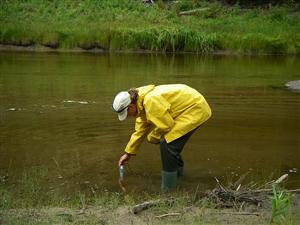Water Quality Indicators: Conventional Variables
Conventional variables are those indicators that are often measured to establish a general picture of the aquatic environment, including the influences of the drainage basin and local environmental conditions, seasonal and annual variability, and the ability to support aquatic life. Some of the most commonly measured conventional variables are described below.
pH
pH is a measurement of the hydrogen ion (H+) concentration in water, and is commonly used to describe the acid/base balance of water. A pH of 7 represents neutral conditions, while pH values greater than 7 indicate basic (alkaline) conditions and pH values less than 7 indicate acidic conditions. The pH of most natural waters is between 6.0 and 8.5. Because pH is calculated as the negative logarithm of the hydrogen ion concentration (i.e., pH=-log([H+]), one pH unit represents a tenfold difference in hydrogen ion concentration; pH 6 is ten times less acidic than pH 5.
Water pH affects both biological and chemical processes. Values of pH below 4.5 and above 9.5 are usually lethal to aquatic organisms, and even less extreme pH values can affect reproduction and other biological processes.
pH affects the solubility of organic compounds, metals, and salts. In highly acidic waters, certain minerals can dissolve and release metals and other chemical substances into the water. pH can also determine the chemical form of some chemical components, which in turn can affect reactivity, bioavailability and toxicity. For example, most metals are more bioavailable (more readily absorbed by living things) at low pH because they are free cations (positively charged). Most organic contaminants are weak organic acids, and are more likely to enter organisms at low pH because they are un-ionized.
For instance, ammonia is a common toxic chemical in water, and takes two forms: ammonia, NH3, and the ammonium ion, NH+. The relative proportion of the two forms depends on pH and temperature. Un-ionized ammonia (NH3) is more toxic to aquatic organisms because it can cross biological membranes such as gills. As pH or temperature rises, the relative proportion of NH3, and hence the toxicity to aquatic organisms, increases.
The pH of a waterbody reflects its water inputs and the chemical characteristics of the surrounding land. The pH of runoff from the land, or of groundwater inputs to surface water, is affected by the type of minerals and soils the water contacts as it moves through the land. Water draining from forests and swamps may be acidic due to weak organic acids contained in the organic matter within these ecosystems.
Total Dissolved Solids and Conductivity
The concentration of total dissolved solids (TDS) is a measure of the amount of dissolved material in water. TDS includes solutes such as sodium, calcium, magnesium, bicarbonate, chloride and others that remain as a solid residue after evaporation of water from the sample. Fresh water usually has TDS levels between 0 and 1,000 mg/L, depending on the geology of the region, climate and weathering, and other geographical features that affect sources of dissolved material and its transport to a water system.
Conductivity is a measure of the ability to conduct an electric current and is the opposite (or reciprocal) of resistance. The higher the concentration of ions in water, the more current the water can conduct. Conductivity is sensitive, then, to the amount of dissolved solids—particularly mineral salts—in the water, and also depends on the amount of electrical charge on each ion, ion mobility, and temperature.
Expressed in units of microsiemens per centimetre (µS/cm), conductivity generally ranges between 10 and 1,000 µS/cm in most rivers or lakes that have outflows. Talling and Talling (1965) suggest this classification of water based on conductivity:
|
Conductivity |
Classification |
|
<600 µS/cm |
Freshwater |
|
600-6000 µS/cm |
Moderately saline |
|
>6000 µS/cm |
Saline |
In addition to natural weathering and input of geologic material, sources of TDS include mining, industrial and sewage effluent, and agriculture. Field measurements of conductivity can be used to delineate a pollution zone, such as the extent of influence of an effluent discharge or run-off waters.
High levels of total dissolved solids and conductivity render water less suitable for drinking and irrigation.
Suspended sediment
Suspended sediment is characterized as the mass of suspended sediment per unit volume of water, in units of mg/L. Particles suspended within the water column are usually less than 0.1 mm in diameter—mostly silt- and clay-sized particles. These particles are transported by flowing water, and settle out when flow is insufficient to keep them in suspension. Concentrations of suspended sediment generally increase during periods of increasing flow from rainfall, reach a maximum at or near the peak of a storm hydrograph, and decrease relatively rapidly with the hydrograph recession limb (Beschta 1996).









